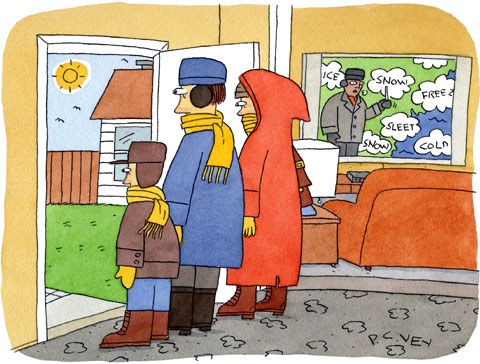Weather Forecasting Is A Dicey Thing
Before examining why longer-term forecasts are less accurate than current forecasts, we look at basic definitions on the types of weather forecasts made in relation to time:
A short-range forecast is a weather forecast made for a time period up to 48 hours.
Extended forecasts are for a period extending beyond three or more days (eg. a three to five-day period) from the day of issuance.
Medium range forecasts are for a period extending from about three days to seven days in advance.
Long-range forecasts are for a period greater than seven days in advance but there are no absolute limits to the period.
Short-range forecast predictions, where the forecast is made for a time period for today and/or tomorrow (up to 48 hours), are generally more accurate than the other types of forecasts. Weather forecasts still have their limitations despite the use of modern technology and improved techniques to predict the weather.
For example, weather forecasts for today or tomorrow are likely to be more dependable than predictions about the weather about two weeks from now. Some sources state that weather forecast accuracy falls significantly beyond about 10 days. Weather forecasting is complex and not always accurate, especially for days further in the future, because the weather can be chaotic and unpredictable.
For example, rain or snow cannot always be predicted with a simple yes or no. Moreover, the Earth’s atmosphere is a complicated system that is affected by many factors and can react in different ways. Weather observation techniques have improved and there have been technological advancements in predicting the weather in recent times.
On average, a five-day weather forecast of today is as reliable as a two-day weather forecast 20 years ago. Despite this major scientific and technical progress, many challenges remain regarding long-term weather predictability.
THE AMERICAN NATIONAL WEATHER SERVICE
“We sustain higher accuracy out to two to three days in advance; then it starts dropping off faster at days six through eight,” says Louis Uccellini, director of the National Weather Service.
That’s why the National Weather Service makes specific weather forecasts — high and low temperature and probability of precipitation — only seven days in advance.
For extreme weather events such as hurricanes and cyclones, the agency sometimes makes longer-term predictions, based on such things as movements of the Madden-Julian Oscillation (a cycle of atmospheric weather in the Indian Ocean and the western Pacific) or the more famous El Nino weather pattern.
The Weather Service also offer a 10-month forecast, but it’s extremely vague, making such predictions as an above-average amount of precipitation over the course of a season. Making specific predictions that far ahead isn’t yet possible, and it may never be, according to Uccellini. He notes that three obstacles prevent scientists from making reliable forecasts even only 10 days in advance: observation systems, numerical models and computing power.
With weather satellites proliferating, there have been tremendous improvements in global data collection over the last decade or so. Computing power has also moved forward rapidly, although the ability to run computations that divide the world into small segments demands a staggering electronic infrastructure.
The models are the real sticking point, but the National Weather Service is making progress by taking a sort of “poll of polls” strategy, to borrow a phrase from political scientists. “We’re now finding that if you run an ensemble of models, merging an envelope of solutions from second and third models, you can extract a more likely solution,” Uccellini says.
Testing on this combined-model approach has suggested that the National Weather Service may be able to push its official forecast out to 10 days, but no decision to do that has been made. (The agency moved from a five-day forecast to a seven-day one only in 2000.)
Sources:
1. Time and date
2. Washington Post
Image 1 source
Image 2 source
Subscribe to:
Post Comments (Atom)
Latest Forecasts/Updates
Popular Posts
-
JUNE 18, 2016 A major rejuvenation of the monsoon in India will occur only on June 23-24. That is when it will push into Mumbai p...
-
Mahasen about to hit Andhra-Orissa coast on May 14th, 2013. The purple color means very strong winds. Mahasen will take birth as a lo...
-
JUNE 1, 2016 The June 1, that is the latest monsoon forecast by the Canadian Meteorological Centre's CANSIPS climate model for India, So...
-
AUGUST 8, 2016, MONDAY The cyclonic circulation which is presently hovering above southeastern Rajasthan will bring very heavy rainfall ...
-
MAY 28, 2016 Mumbai will receive upto 4-5 inches of rain by June 12, 2016. Hardly a sign of a delayed weak monsoon. Though the Indian Meteo...
-
IR Satellite image of the depression that remains of the once powerful cyclone Nanauk. Image taken 0000 Hrs GMT, June 14, 2014 (Saturd...
-
JUNE 20, 2017, TUESDAY Monsoon is going to intensify in the coming days. A low pressure system is expected to form in the Bay of Bengal by ...
-
APRIL 14, 2017 The US Climate Prediction Center has hinted strongly at the possibility of a tropical cyclone in the Arabian Sea in earl...
-
AUGUST 7, 2016, SUNDAY The rain system over Gujarat-Sindh is weakening. Meanwhile the cyclonic circulation over Madhya Pradesh will move to...
-
APRIL 12, 2017 A low pressure area is being gradually formed in the Bay of Bengal. A look at the latest satellite image of the sea reveals m...


















No comments:
Post a Comment